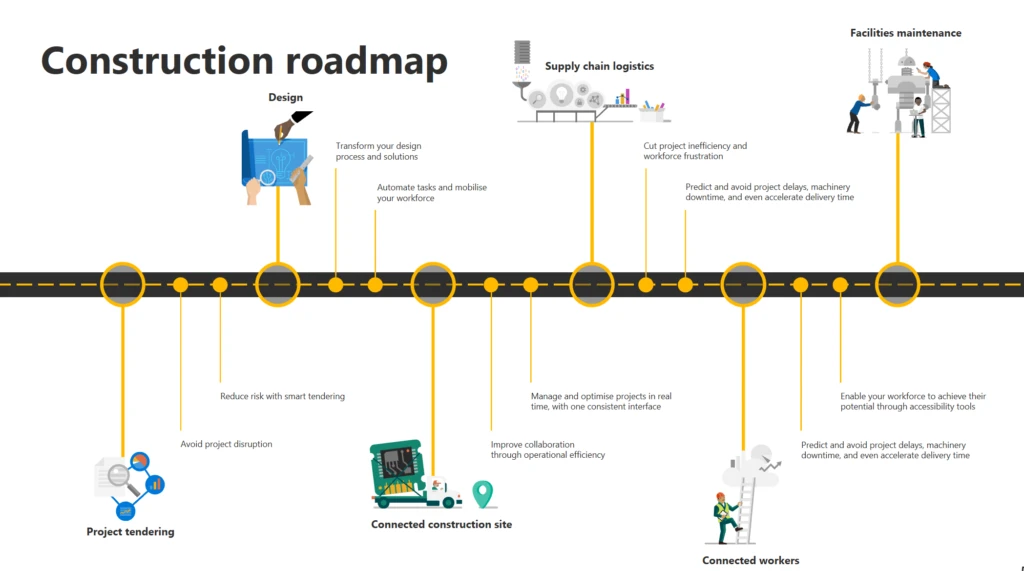
5 ways to super-charge productivity in UK construction
 Labour productivity growth in global construction has averaged just 1 percent a year over the past 20 years – well below the 2.8 percent growth for the total world economy.
Labour productivity growth in global construction has averaged just 1 percent a year over the past 20 years – well below the 2.8 percent growth for the total world economy.
However, with a growing population to house, increasing pressure to boost its green credentials, and a skills shortage to mitigate, the architecture, engineering, and construction sector must take drastic steps to boost its output and get on the front foot.
This is why organisations must empower employees with modern tools and apps to transform and stay competitive. Here are five ways firms can knuckle-down and meet the challenges of today’s tough environment.

1. Put projects under the microscope
Accurate and up-to-date budgeting and scheduling is a perennial challenge. Projects regularly run into unforeseen difficulties that require deviations from the estimated cost and schedule. For example, sub-optimal soil conditions that necessitate a change in material or design. More often than not, these problems are detected too late, which limits companies’ ability to respond proactively.
A company can use data and communication to its strengths here. By monitoring projects ahead and in real time and using technology to make it easier for teams to communicate, you can quickly identify the root causes and implement remedies immediately and efficiently.
2. Get a digital make-over
 Construction is among the least digitised sectors in the world, according to MGI’s digitisation index. In Europe, construction ranks last. However, the benefits of digitisation are exponential. For example, the use of virtual reality and simulation can help to identify potential problems during the design and engineering stages, and enable a more in-depth experience of a building early-on.
Construction is among the least digitised sectors in the world, according to MGI’s digitisation index. In Europe, construction ranks last. However, the benefits of digitisation are exponential. For example, the use of virtual reality and simulation can help to identify potential problems during the design and engineering stages, and enable a more in-depth experience of a building early-on.
British engineering firm Atkins saw a 95 percent time improvement after implementing parametric design techniques in the water infrastructure industry.
Digitally enabled procurement and supply chain work flows can allow for more sophisticated logistics management and just-in-time delivery. Dynamics 365 This makes it easier for employees to have oversight over the supply chain and pre-empt issues or shortages.
Technologies like mobile connectivity can boost productivity by facilitating real-time communications between stakeholders across disparate locations. Frontline workers are empowered with flexible devices such as the Surface, which offers 4G connectivity. This makes it easier for them to communicate, collaborate, and remain productive wherever they are.
3. Establish lines of communication
 A seamless flow of information among stakeholders throughout an entire project lifetime, for example, through building information modelling (BIM) or a centralised cloud platform, can speed up delivery, mitigate against disputes, and improve forecasting and budgeting. It also produces a continuous build-up of knowledge that can be usefully applied to subsequent projects – even if that project is unique. Given the largely sequential construction process favoured at present, in which project owners, designers, constructors and suppliers input at different stages of the project, past experience is often lost and a sophisticated construction planning approach is near-impossible.
A seamless flow of information among stakeholders throughout an entire project lifetime, for example, through building information modelling (BIM) or a centralised cloud platform, can speed up delivery, mitigate against disputes, and improve forecasting and budgeting. It also produces a continuous build-up of knowledge that can be usefully applied to subsequent projects – even if that project is unique. Given the largely sequential construction process favoured at present, in which project owners, designers, constructors and suppliers input at different stages of the project, past experience is often lost and a sophisticated construction planning approach is near-impossible.
4. Optimise existing processes
Improving efficiencies to existing techniques can have lasting effects on productivity. For instance, adoption of “lean” principles has been shown to reduce completion times by 30 percent and cut costs by 15 percent. Institutionalising value engineering and moving away from custom scopes for each project toward standardisation and repeatability can contribute to an uptick in productivity by up to 60 percent.
Dynamics 365 integrates data and apps to help streamline processes from planning to cost and revenue forecasting. By removing common silos found in organisations, Dynamics 365 lets employees get an overview of the information they need, when the need it.
5. Put the spotlight on talent
 Without the right people supporting and driving organisational and cross-industry initiatives, change will not be successful. Construction and engineering companies must therefore focus much of their effort on attracting, retaining, and up-skilling talent.
Without the right people supporting and driving organisational and cross-industry initiatives, change will not be successful. Construction and engineering companies must therefore focus much of their effort on attracting, retaining, and up-skilling talent.
They must also focus on fostering a culture that is innovation and skills-oriented. This is particularly pertinent at a time when one in five construction workers are approaching retirement age and young people’s perception of the industry is low. As firms move to adopt new technologies such as drones and artificial intelligence, they will need specific skills to help power them.
Because more and more jobs are requiring digital proficiency, it’s important to support your employees in gaining new skills. At Microsoft, we’re committed to helping organisations build these skills. That’s why we’ve created the Digital Skills programme that offers courses from basic literacy to advanced cloud technology skills and even how to maximise the AI opportunity.
 A human-centred approach
A human-centred approach
The most important thing is not to use technology for the sake of it. Think about the goals and values of your organisation. Then figure out how to use technology to reach those. This could be streamlining processes, tracking supply chain, or upskilling your employees.
If this is done with a human-centred approach then your employees will be empowered to embrace digital transformation, leading your organisation to be more productive, collaborative, and creating an innovative culture.




